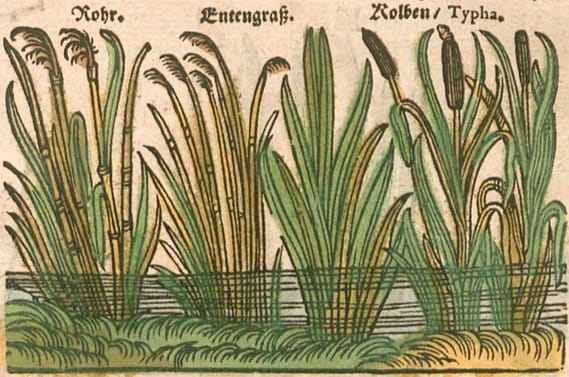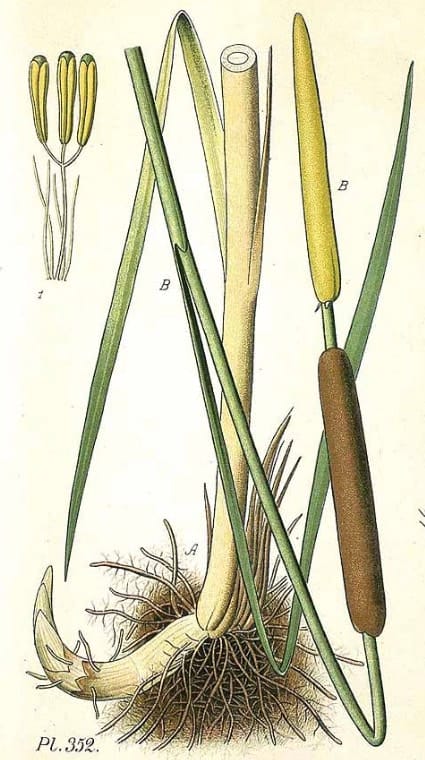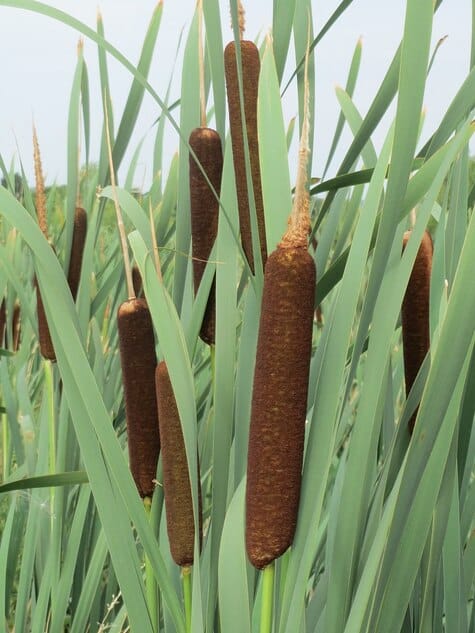Typha, Cattail pollen, Pu Huang 蒲黄Bulrush, Juncus asperPu Huang (TCM) |

|
 Cattail (right)
Cattail (right)Krauterbuch, Lonitzer, 1578
 Typha angustifolia
Typha angustifoliaA. Masclef, Atlas des plantes de France, vol. 3 (1893)
 Typha latifolia
Typha latifolia(Photo by AnRo0002) (Wikimedia)
Botanical name:
Typha spp:
- T. latifolia (Common Cattail-common Western source; also used in TCM)
- T. angustifolia (Official TCM source)
- T. orientalis (Oriental Cattail–Official TCM source)
- T. angustata
- T. minima
Parts used:
Pollen (TCM); the Down was most used in the West for external purposes.
Temperature & Taste:
Neutral. Sweet, Pungent (regarded as mildly Cool and dry in the West)
Classification:
L. Stop Bleeding
Uses:
1. Stops Bleeding: (TCM, West)
-topically to stop external Bleeding (TCM, West)
-Coughing or Spitting Blood, Blood in the Urine or Stool
-Uterine Bleeding
-subcutaneous bleeding
-‘threatened abortion with vaginal bleeding’ (Da Ming)
2. Moves the Blood, Clears Stasis: (TCM)
-Chest Pain
-Menstrual Pain, Postpartum Abdominal Pain
-Retention of the Lochia (expels Afterbirth)
-‘relieves afterpains’ (Da Ming)
3. Clears Heat, Promotes Urine: (TCM)
-hot and painful dribbling Urine
-Burning urine with Blood in the Urine
4. Benefits Qi, Treats Hernia: (West)
-makes the body light, tonifies Qi and prolongs life with continued use. (Shen Nong Ben Cao)
-used for Hernia (West)
5. Externally:
-applied topically to stop Bleeding Wounds; both the fluffy down and the pollen have been used (TCM, West)
-pollen is applied topically to mouth Ulcers
-pollen is applied to itching, damp skin sores
-the fluffy down is applied to ‘Moist Sores and Running Ulcers’ (Salmon)
-mixed with Hog’s lard and applied to Burns and Scalds (Dioscorides)
-mixed with Honey and applied to painful and swollen Sores

Dose:
Powder: 1–4 grams
Decoction: 3–9 grams
Pollen or the soft white down is applied to moist sores and Ulcers.
Comment:
1. Regarded as ‘Slippery’ in its raw form, astringent when dry-fried.
2. It treats various types of Bleeding without causing blood stasis.
Preparation:
1. Unprepared Herb
Best for Blood stagnation, and to promote Urine.
2. Dry-Fried Cattail Pollen
Stir-fried until browned or charred (carbonized).
This is best to stop Bleeding. However, research has shown the herb is also effective to stop Bleeding without being Dry-Fried. Today, many practitioners in China use the raw (unprepared) Herb for all uses.
3. Wine-Fried Cattail Pollen:
This is stronger to move the Blood.
4. Vinegar-fried Cattail Pollen:
Used to stop Bleeding and easy Pain.
Main Combinations:
1. Blood Stasis:
i. epigastric and abdominal pain, Cattail Pollen with Trogopterus Wu Ling Zhi (Shi Xiao San)
ii. lower abdominal pain, Cattail pollen, Safflower (Hong Hua), Peach kernel (Tao Ren), Zedoary (E Zhu)
2. Prolonged or Irregular Uterine Bleeding:
i. Cattail Pollen with Mugwort (Ai Ye)
ii. Cattail Pollen with Cuttlefish bone
iii. Cattail Pollen with Platycladus Ce Bai Ye
iv. chronic continuous Uterine Bleeding with exhausted Kidney Essence, Cattail Pollen with Velvet Deer horn (Lu Rong), and Dang Gui.
3. Postpartum Bleeding:
i. Cattail Pollen with Motherwort (Yi Mu Cao)
ii. Cattail Pollen with Motherwort (Yi Mu Cao), Dang Gui, Astragalaus Huang Qi, Chinese Red dates (Da Zao)
4. Retention of the Lochia, Cattail Pollen with Motherwort (Yi Mu Cao), Dang Gui
5. Stop Bleeding:
i. a tea can be prepared from the carbonized Cattail pollen
ii. Coughing or Vomiting Blood, Cattail Pollen with Dioscorea bulbifera Huang Yao Zi
6. Painful dribbling Urine with Blood:
i. Cattail Pollen with Akebia Mu Tong
ii. Cattail Pollen with Plantain seed (Che Qian Zi)
iii. Cattail Pollen with Lotus root (Ou Jie), Akebia Mu Tong.
iv. with stabbing pain, Cattail Pollen with Pyrrosia (Shi Wei) and Gardenia Zhi Zi
7. Pain from Trauma:
i. Cattail Pollen with Myrrh and Safflower
ii. Cattail Pollen with Notoginseng San Qi, Safflower (Hong Hua), Peach kernel (Tao Ren)
8. Hernia, powders of Cattail Pollen, Betony, Gladioli root, Horsetongue leaves, 1 dram mixed with Egg Yolk and eaten daily for 30 days (Gerard)
9. Topically to Stop Bleeding:
i. Cattail Pollen with Cuttlefish bone
ii. Carbonized Cattail pollen, Alum
10. Chronic non-healing Ulcers, Cattail Pollen with Dragon’s Blood topically as a powder
11. Swelling of the tongue:
i. rub the powder of Cattail Pollen on the tongue (Li Shi Zhen)
ii. take equal parts of Cattail Pollen and Ginger, powder, and rub on the tongue. (Zhi Yin Fang)
Major Formulas:
Shao Fu Zhu Yu Tang
Yan Hu Suo Tang
Qi Zhen San
Shi Xiao San
Xiao Ji Yin Zi
Cautions:
1. Not used during Pregnancy. Occasionally, the charred Cattail Pollen has been administered but the raw material should never be used.
